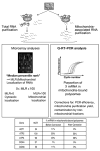Yeast mitochondrial transcriptomics
- PMID: 18314748
- PMCID: PMC4943872
- DOI: 10.1007/978-1-59745-365-3_35
Yeast mitochondrial transcriptomics
Abstract
Although 30 years ago it was strongly suggested that some cytoplasmic ribosomes are bound to the surface of yeast mitochondria, the mechanisms and the raison d'être of this process are not understood. For instance, it is not perfectly known which of the several hundred nuclearly encoded genes have to be translated to the mitochondrial vicinity to guide the import of the corresponding proteins. One can take advantage of several modern methods to address a number of aspects of the site-specific translation process of messenger ribonucleic acid (mRNA) coding for proteins imported into mitochondria. Three complementary approaches are presented to analyze the spatial distribution of mRNAs coding for proteins imported into mitochondria. Starting from biochemical purifications of mitochondria-bound polysomes, we describe a genomewide approach to classify all the cellular mRNAs according to their physical proximity with mitochondria; we also present real-time quantitative reverse transcription polymerase chain reaction monitoring of mRNA distribution to provide a quantified description of this localization. Finally, a fluorescence microscopy approach on a single living cell is described to visualize the in vivo localization of mRNAs involved in mitochondria biogenesis.
Figures



References
-
- Schatz G, Dobberstein B. Common principles of protein translocation across membranes. Science. 1996;271:1519–1526. - PubMed
-
- Neupert W. Protein import into mitochondria. Annu Rev Biochem. 1997;66:863–917. - PubMed
-
- Verner K. Co-translational protein import into mitochondria: an alternative view. Trends Biochem Sci. 1993;18:366–371. - PubMed
-
- Suissa M, Schatz G. Import of proteins into mitochondria. Translatable mRNAs for imported mitochondrial proteins are present in free as well as mitochondria-bound cytoplasmic polysomes. J Biol Chem. 1982;257:13,048–13,055. - PubMed
Publication types
MeSH terms
Substances
Grants and funding
LinkOut - more resources
Full Text Sources
Molecular Biology Databases

